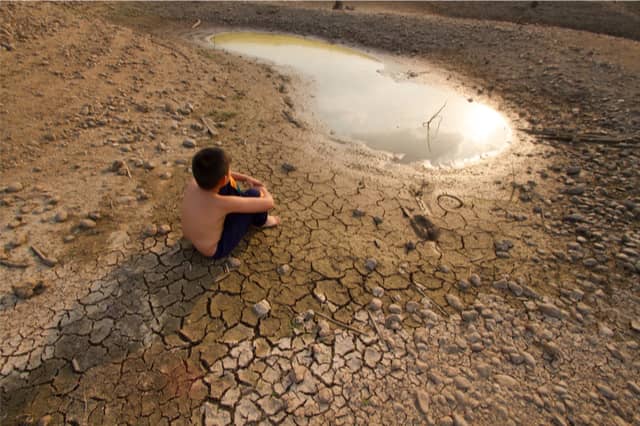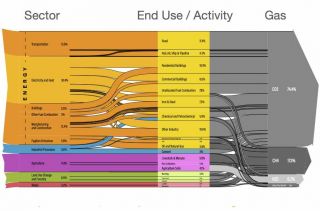
www.buildingsandcities.org/insights/commentaries/cop26-youth.html
Responsibilities to the 'Climate Generation'

By Raymond J. Cole (University of British Columbia, CA)
For the foreseeable future, the current young generation and those following will be navigating through a difficult, turbulent period and have to prepare for a changing world - what Yunkaporta (2020) characterizes as the creation of 'cultures and societies of transition' toward a qualitatively different future era. Intergenerational obligations and rights have a long history in moral and ethical philosophy and legal discussions and, indeed, Article 24 of the Convention on the Rights of the Child declares their right to a safe and healthy future. The climate emergency is a child rights issue and governments participating in COP-26 have an obligation to acknowledge this fundamental right in their decision-making about climate change policies and commit to placing a price on any pollution that threatens children's futures (Vandergrift, 2020).
The Director-General of United Nations Educational, Scientific and Cultural Organization (UNESCO), Amadou-Mahtar M'Bow, characterised the world in the 1970s as one threatened by over-armed super-powers, stark disparities in technological capability, and global inequities in the distribution of wealth and educational opportunities. In anticipation of the 1979 International Year of the Child he posed an 'alarming question': What kind of world are we leaving our children? in a UNESCO round-table event and book (M'Bow, 1978: 11) with the same title. Answering this, M'Bow called for a 'self-examination' of his generation's responsibilities to the next - largely one of creating a safe, just world for it to inherit. Futurist Alvin Toffler's (1978: 25) essay considered that it was 'terrifying to be alive' at that moment of history and that 'no previous generation ever faced such challenges'. Italian industrialist and founder of the Club of Rome, Aurelio Peccei, was concerned about how far along a downward path humankind had 'already progressed' and that with the resulting emergency, time was of the essence. He considered that within a decade, the 'options that we have today of choosing our future will certainly be reduced. We shall have many fewer options than we have today. Why wait, then? It is totally stupid to wait' (Peccei, 1978: 121). Moreover, physician Hans Suyin questioned why the voice of children was not present in the round table deliberations and considered a dialogue with them about the 'world we have made, the world they will inherit' (Suyin, 1978: 70) to be essential. Toffler, Peccei and Suyin's arguments would seem equally, if not more, apt today when many of the disparities and inequities evident in the 1970s remain yet now exist within the context of a climate emergency.
Although climate
change is currently unfolding at a frighteningly rapid pace, achieving
international commitment, consensus, and agreements to enforce necessary action
takes time - a painfully
long time. After 20 years of negotiations, the Paris Agreement reached at COP-21
in 2015 unanimously adopted a
pledge to keep global warming below 2 ºC above pre-industrial levels and continue efforts to
limit it to 1.5 ºC. Unfortunately, even after two additional days of
deliberations, 'deep rifts' among industrialized nations, fast-growing
economies and poor countries, and 'political polarization' among the US, China
and the EU (Coleman and Oroschakoff, 2019) thwarted the COP-25 meeting in 2019
in preparing the way for its implementation post-2020 (Chidede, 2019). Despite 25 years of UN
Climate Change Conferences, global GHG emissions have
increased more than 40% over that period and failure to
curb global warming may now trigger abrupt and irreversible changes in climate systems - a precarious situation for us and other species.
Expectations for COP-26? It certainly must resolve remaining issues in the Paris
Agreement, particularly those related to a common price of carbon and committing to timeframes for
implementing substantive climate action plans. Moreover, not only should all participating leaders shed their defence of short-sighted national interests, but also directly involve the young generation and position the future of all children as an overarching frame for their deliberations.
Children have increasingly 'participated' in previous COP meetings at the invitation of UN Framework Convention on Climate Change (UNFCCC) secretariat despite stipulations that participants be older than 18 (United Nations, 2010). Most recently, the then 16 year old Greta Thunberg provided a powerful 12-minute plenary speech at COP-25 in 2019 that criticized and challenged the lack of action and urgency by governments. She received resounding applause from the audience and apparently their approval of her arguments. Earlier in the conference, United Nations Children's Fund (UNICEF) hosted a panel including five young climate activists - two of whom were age 16 and one 15 years old - and launched the Intergovernmental Declaration on Children, Youth and Climate Action (UNICEF, 2019) urging Member States to engage youth as part of their climate plans and decision-making. Remarkably, despite having demonstrated the value of their contributions, the expectation that children would be granted a greater presence and voice at COP-26 looks to be sadly dashed (World Vision, 2020). COP-26 may therefore possibly be remembered as another lost opportunity to fully engage a 'climate generation' who have lost confidence in political leaders to ensure their future.
References
Chidede, T. (2019). Outcomes of COP25.
Coleman, Z. and Oroschakoff, K. (2019). UN climate talks fall short thanks to US vacuum, Politico.
M'Bow, A.-M. (1978). What kind of world are we leaving our children? Paris: UNESCO.
Peccei, A. (1978). Man, an abandoned world. In: A.-M. M'Bow (ed.) What kind of world are we leaving our children? Paris: UNESCO, 120-122.
Suyin, H. (1978). They have their word to say. In: A.-M. M'Bow (ed.), What kind of world are we leaving our children? Paris: UNESCO, 66-70.
Toffler, A. (1978). Chaos, anarchy or a changing civilization? In: Amadou-Mahtar M'Bow (ed.), What kind of world are we leaving our children? Paris: UNESCO, 23-25.
UNICEF. (2019). Declaration on Children, Youth and Climate Action. New York: United Nations Children's Fund.
United Nations. (2010). Youth Participation in the UNFCCC Negotiation Process: The United Nations, Young People, and Climate Change. UN Joint Framework Initiative on Children, Youth and Climate Change.
Vandergrift, K. (2020). Climate Change Court Challenge: Children's Rights at Supreme Court, Children's Rights in Canada. 21 September.
World Vision (2020). Aid agency warns: Children left out of crucial climate summit. World Vision.
Yunkaporta, T. (2020). Sand Talk, How Indigenous Thinking Can Save the World, New York: HarperCollins.
Latest Peer-Reviewed Journal Content
A framework for 1.5°C-aligned GHG budgets in architecture
G Betti, I Spaar, D Bachmann, A Jerosch-Herold, E Kühner, R Yang, K Avhad & S Sinning
Net zero retrofit of the building stock [editorial]
D Godoy-Shimizu & P Steadman
Co-learning in living labs: nurturing civic agency and resilience
A Belfield
The importance of multi-roles and code-switching in living labs
H Noller & A Tarik
Researchers’ shifting roles in living labs for knowledge co-production
C-C Dobre & G Faldi
Increasing civic resilience in urban living labs: city authorities’ roles
E Alatalo, M Laine & M Kyrönviita
Co-curation as civic practice in community engagement
Z Li, M Sunikka-Blank, R Purohit & F Samuel
Preserving buildings: emission reductions from circular economy strategies in Austria
N Alaux, V Kulmer, J Vogel & A Passer
Urban living labs: relationality between institutions and local circularity
P Palo, M Adelfio, J Lundin & E Brandão
Living labs: epistemic modelling, temporariness and land value
J Clossick, T Khonsari & U Steven
Co-creating interventions to prevent mosquito-borne disease transmission in hospitals
O Sloan Wood, E Lupenza, D M Agnello, J B Knudsen, M Msellem, K L Schiøler & F Saleh
Circularity at the neighbourhood scale: co-creative living lab lessons
J Honsa, A Versele, T Van de Kerckhove & C Piccardo
Positive energy districts and energy communities: how living labs create value
E Malakhatka, O Shafqat, A Sandoff & L Thuvander
Built environment governance and professionalism: the end of laissez-faire (again)
S Foxell
Co-creating justice in housing energy transitions through energy living labs
D Ricci, C Leiwakabessy, S van Wieringen, P de Koning & T Konstantinou
HVAC characterisation of existing Canadian buildings for decarbonisation retrofit identification
J Adebisi & J J McArthur
Simulation and the building performance gap [editorial]
M Donn
Developing criteria for effective building-sector commitments in nationally determined contributions
P Graham, K McFarlane & M Taheri
Reimagining circularity: actions for optimising the use of existing buildings
R Lundgren, R Kyrö, S Toivonen & L Tähtinen
Effective interdisciplinary stakeholder engagement in net zero building design
S Vakeva-Baird, F Tahmasebi, JJ Williams & D Mumovic
Metrics for building component disassembly potential: a practical framework
H Järvelä, A Lehto, T Pirilä & M Kuittinen
The unfitness of dwellings: why spatial and conceptual boundaries matter
E Nisonen, D Milián Bernal & S Pelsmakers
Environmental variables and air quality: implications for planning and public health
H Itzhak-Ben-Shalom, T Saroglou, V Multanen, A Vanunu, A Karnieli, D Katoshevski, N Davidovitch & I A Meir
Exploring diverse drivers behind hybrid heating solutions
S Kilpeläinen, S Pelsmakers, R Castaño-Rosa & M-S Miettinen
Urban rooms and the expanded ecology of urban living labs
E Akbil & C Butterworth
Living with extreme heat: perceptions and experiences
L King & C Demski
A systemic decision-making model for energy retrofits
C Schünemann, M Dshemuchadse & S Scherbaum
Modelling site-specific outdoor temperature for buildings in urban environments
K Cebrat, J Narożny, M Baborska-Narożny & M Smektała
Understanding shading through home-use experience, measurement and modelling
M Baborska-Narożny, K Bandurski, & M Grudzińska
Building performance simulation for sensemaking in architectural pedagogy
M Bohm
Beyond the building: governance challenges in social housing retrofit
H Charles
Heat stress in social housing districts: tree cover–built form interaction
C Lopez-Ordoñez, E Garcia-Nevado, H Coch & M Morganti
An observational analysis of shade-related pedestrian activity
M Levenson, D Pearlmutter & O Aleksandrowicz
Learning to sail a building: a people-first approach to retrofit
B Bordass, R Pender, K Steele & A Graham
Market transformations: gas conversion as a blueprint for net zero retrofit
A Gillich
Resistance against zero-emission neighbourhood infrastructuring: key lessons from Norway
T Berker & R Woods
Megatrends and weak signals shaping future real estate
S Toivonen
A strategic niche management framework to scale deep energy retrofits
T H King & M Jemtrud
Generative AI: reconfiguring supervision and doctoral research
P Boyd & D Harding
Exploring interactions between shading and view using visual difference prediction
S Wasilewski & M Andersen
How urban green infrastructure contributes to carbon neutrality [briefing note]
R Hautamäki, L Kulmala, M Ariluoma & L Järvi
Implementing and operating net zero buildings in South Africa
R Terblanche, C May & J Steward
Quantifying inter-dwelling air exchanges during fan pressurisation tests
D Glew, F Thomas, D Miles-Shenton & J Parker
Western Asian and Northern African residential building stocks: archetype analysis
S Akin, A Eghbali, C Nwagwu & E Hertwich
Join Our Community

The most important part of any journal is our people – readers, authors, reviewers, editorial board members and editors. You are cordially invited to join our community by joining our mailing list. We send out occasional emails about the journal – calls for papers, special issues, events and more.
We will not share your email with third parties. Read more



Latest Commentaries
COP30 Report
Matti Kuittinen (Aalto University) reflects on his experience of attending the 2025 UN Conference of the Parties in Belém, Brazil. The roadmaps and commitments failed to deliver the objectives of the 2025 Paris Agreement. However, 2 countries - Japan and Senegal - announced they are creating roadmaps to decarbonise their buildings. An international group of government ministers put housing on the agenda - specifying the need for reduced carbon and energy use along with affordability, quality and climate resilience.
Building-Related Research: New Context, New Challenges
Raymond J. Cole (University of British Columbia) reflects on the key challenges raised in the 34 commissioned essays for Buildings & Cities 5th anniversary. Not only are key research issues identified, but the consequences of changing contexts for conducting research and tailoring its influence on society are highlighted as key areas of action.